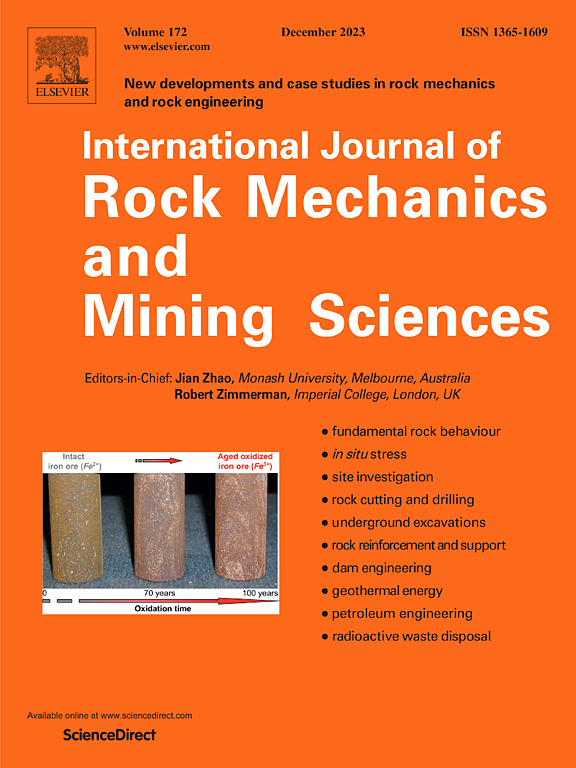应力波对断层滑动影响的光弹性分析与数值模拟
IF 7
1区 工程技术
Q1 ENGINEERING, GEOLOGICAL
International Journal of Rock Mechanics and Mining Sciences
Pub Date : 2025-02-01
DOI:10.1016/j.ijrmms.2025.106026
引用次数: 0
摘要
在煤矿开采过程中,断层滑动经常受到岩石破裂产生的应力波的影响,但应力波对断层滑动的影响尚不清楚。为了解这种影响,本文以一马煤田F16逆冲断层为研究对象,进行了光弹性实验和数值模拟。考虑了应力波源、应力波能量和断层静摩擦系数三个因素。结果表明:(1)位于下部地层的应力波源更容易引发断层滑动。(2)上断裂带滑动位移、应变比rε(剪切应变与法向应变)和应力比rσ(剪应力与法向应力)随应力波能量的增加呈“U”型曲线。当应力波能量较大时,上断裂带的岩石破坏可能是产生上升曲线的原因。(3)正应力和剪应力对应力波扰动的响应不同。(4)断层静摩擦系数较大时,应力波引起的摩擦能增大,滑动位移减小。(5)当应力波能量足够高时,断层的莫尔圈会达到库仑破坏阈值,导致断层滑动。本文章由计算机程序翻译,如有差异,请以英文原文为准。
Effect of stress waves on fault slip using photoelastic analysis and numerical simulation
In coal mines, fault slips are often affected by stress waves originated from rock fracture during mining, but the effect of stress waves on a fault slip is still unclear. To understand such an effect, photoelasticity experiments and numerical simulation were carried out in this study, based on the thrust fault F16 in the Yima coal field, China. Three factors including stress wave sources, stress wave energy, and static friction coefficients of the fault were considered. The results show that: (1) Sources of stress waves located in the lower strata can more likely trigger the fault slip. (2) The curves of sliding displacement, strain ratio (shear strain to normal strain), and stress ratio (shear stress to normal stress) of the upper fault are similar to “U” shape with increasing stress wave energy. The rock failure in the upper fault could be the reason of the rising curves when the stress wave energy is high. (3) Normal and shear stresses have different responses to the perturbation of stress waves. (4) More friction energy but less sliding displacement is induced by stress waves if the static friction coefficient of the fault is large. (5) The Mohr's circle of the fault can reach the Coulomb failure threshold if the energy of stress waves is high enough, resulting in fault slip.
求助全文
通过发布文献求助,成功后即可免费获取论文全文。
去求助
来源期刊
CiteScore
14.00
自引率
5.60%
发文量
196
审稿时长
18 weeks
期刊介绍:
The International Journal of Rock Mechanics and Mining Sciences focuses on original research, new developments, site measurements, and case studies within the fields of rock mechanics and rock engineering. Serving as an international platform, it showcases high-quality papers addressing rock mechanics and the application of its principles and techniques in mining and civil engineering projects situated on or within rock masses. These projects encompass a wide range, including slopes, open-pit mines, quarries, shafts, tunnels, caverns, underground mines, metro systems, dams, hydro-electric stations, geothermal energy, petroleum engineering, and radioactive waste disposal. The journal welcomes submissions on various topics, with particular interest in theoretical advancements, analytical and numerical methods, rock testing, site investigation, and case studies.

 求助内容:
求助内容: 应助结果提醒方式:
应助结果提醒方式:


